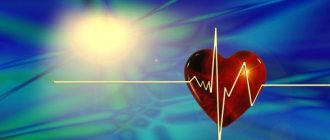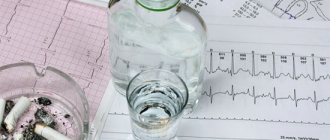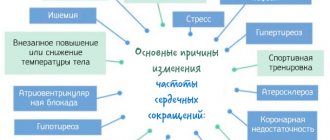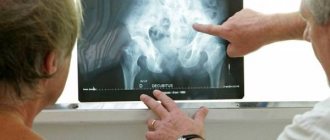Atherosclerotic cardiosclerosis is one of the types of ischemia of the cardiac organ, which is marked by a disturbance in the blood supply to the heart and disruption of blood flow.
Cardiosclerosis develops due to progressive systemic atherosclerosis of the coronary arteries.
Atherosclerotic cardiosclerosis manifests itself due to hypoxia of the cardiac organ from insufficient blood supply, due to narrowing of the coronary vessels during sclerosis.
This process is irreversible in the myocardium, when cardiomyocytes are replaced by connective and fibrous tissue, which significantly complicates the functioning of the heart chambers.
Quite often, atherosclerotic myocardial cardiosclerosis develops in patients after 55 years of age.
Atherosclerotic myocardial damage
The pathology is characterized by an enlargement of the heart organ and its left-sided ventricle, and the heart rhythm is disturbed.
Symptoms are in many ways similar to signs of development of cardiac organ failure.
Before cardiosclerosis begins to develop in the myocardium, the patient may suffer from cardiac pathologies and unstable angina for a long period of time.
Scarring of the myocardium occurs due to insufficient blood flow in it and the development of coronary artery sclerosis.
For this reason, many foci of necrotic changes in the heart muscle form in the myocardium.
Quite often, atherosclerotic cardiosclerosis is accompanied by the following pathologies of the heart and blood flow system:
- Arterial hypertension;
- Aortocardiosclerosis;
- Atrial fibrillation;
- Atherosclerosis of cerebral arteries.
Myocardial scarring
Clinical treatment guidelines
The goals of treatment of coronary atherosclerosis are:
- reducing cholesterol intake;
- reducing cholesterol synthesis with medications;
- acceleration of the elimination of cholesterol and its derivatives;
- impact on other causes: replacement therapy for hormonal imbalance, diabetes.
To reduce the intake of cholesterol into the body, the patient must follow the clinical recommendations of the doctor:
- eliminate bad habits;
- follow a diet;
- normalize weight;
- take prescribed medications in the prescribed dosage.
Patients are prescribed drugs that affect lipid metabolism:
- nicotinic acid preparations: Enduracin, Tredaptiv;
- statins: Avestatin, Vasilip, Zovatin, Zocor;
- fibrates: Lipantil, Traikor, Trilipix, Fenofibrate, Exlip;
- bile acid sequestrants.
The effects of nicotinic acid preparations are manifested in lowering cholesterol levels. Recommended for use with antiplatelet agents (Aspirin). Fibrates improve the synthesis of “good” cholesterol, slow down the growth of plaques, but do not resolve them. Bile acid sequestrants accelerate the excretion of lipids and their derivatives. Statins have the most powerful lipid-lowering effect.
Important! During the course of treatment, liver function is monitored.
Pathogenesis and causes of pathology
When the myocardium is replaced by cardiomyocyte cells with connective tissue, scarring occurs and the myocardium loses its elasticity and contractility.
Scarring can occur for several reasons:
- After inflammation of the heart organ (pathology myocarditis) . The cause of myocarditis in children is viral and infectious diseases, such as measles, chicken pox, scarlet fever. In adults, the cause of the development of cardioatherosclerosis can be diseases - pulmonary tuberculosis and syphilis. When treating myocarditis, the pathology attenuates, but the muscular cardiac myocardial tissue is replaced by a scar of fibrous tissue. This process is called myocardial cardiosclerosis;
- After surgery on the cardiac myocardium , scarring also occurs at the site of surgical work, which causes the development of atherosclerotic cardiosclerosis with necrotic consequences;
- After necrotic focal cardiosclerosis and post-infarction sclerosis of the cardiac myocardium . After myocardial infarction in the acute form of development, the necrotic area is so fragile to rupture that it is necessary to carry out complex treatment so that a dense scar can form at this site and prevent myocardial rupture;
- The pathology of coronary artery sclerosis is one of the reasons for the development of this cardiac pathology, which is provoked by ischemia of the cardiac organ. Ischemia occurs due to the deposition of atherosclerotic plaque in the coronary arteries, as well as atherosclerotic neoplasms in the arteries of the cardiac organ. Cardiac ischemia manifests itself in almost every person in extreme old age, even without the development of coronary sclerosis.
The pathology of coronary artery sclerosis is one of the causes of the development of cardiac pathology
Causes
The causes of atherosclerosis are complex and still not understood. Atherosclerosis, according to clinicians, begins when the inner layer of an artery is damaged. The walls of blood vessels react to such damage by forming plaques that should cover the wound surface. As these layers grow, they gradually narrow the blood vessels, making it difficult for blood to flow. Under certain conditions, they are destroyed and can circulate with the bloodstream throughout the body. They can clog small vessels and disrupt the blood supply to organs.
Risk factors
The main reason for the development of atherosclerotic cardiosclerosis is the accumulation of cholesterol deposits on the endothelium of the coronary arteries that supply the heart muscle with blood.
The process of formation of atherosclerotic plaques in the coronary arteries is stenosing aortic coronary sclerosis.
Provoking factors for the development of atherosclerotic changes in the aorta and coronary arteries:
- Nicotine and alcohol addiction . This is a fairly important factor in the development of atherosclerotic cardiosclerosis and sclerosis of the coronary arteries. During smoking and drinking alcoholic beverages, the cardiac myocardium begins to work under increased load and increases the risk of developing sclerosis of the heart and coronary arteries by 20.0%;
- Hypertension leads to increased load on the cardiac organ , which causes dysfunction of the heart valve apparatus, and is also accompanied by fibrous scarring on the heart valves and on the myocardium of the left ventricle;
- High concentration of lipids in the blood . Cholesterol is the basis of atherosclerotic plaque, and high cholesterol concentrations contribute to the development of cardiosclerosis;
- Insufficient activity leads to an increase in the cholesterol index in the body , as well as an increase in glucose, and the blood becomes more viscous and can form blood clots and emboli. Physical inactivity causes not only atherosclerosis of the coronary arteries, but also the pathology of diabetes mellitus, and with low activity, metabolism in the body is completely disrupted;
- Obesity . This pathology is a consequence of impaired metabolism, and becomes the cause of the development of atherocardiosclerosis;
- Diabetes mellitus increases the risk of developing atherosclerotic changes not only in the arterial endothelium , but also in cardiomyocytes, causing atrophic scarring syndrome of the cardiac myocardium;
- Renal organ failure can provoke arterial hypertension , which causes fibrous scarring of the left ventricle;
- Poor nutrition . The reason for the accumulation of plaques in the coronary arteries is eating foods that contain a high content of animal fat. Also, the development of plaques is caused by foods that can disrupt lipid and carbohydrate metabolism and metabolism in the human body;
- Inherited genetic predisposition to the accumulation of excess cholesterol and the development of systemic atherosclerosis . With a hereditary factor in the development of atherosclerotic neoplasms, atherosclerosis of various locations develops 8 times more often than the occurrence of pathology without a family predisposition;
- The gender and age of patients in men after 40 - 45 years of age is diagnosed with the development of atherosclerosis in various locations 5 times higher than in women. Also, men suffer more often from atherosclerotic atherosclerosis and its consequences of myocardial infarction than women. But cardiosclerosis as a cause of death is diagnosed more often in women than in men.
Nicotine and alcohol addiction
Atherosclerotic cardiosclerosis: ICD-10 code, causes, treatment
Cardiosclerosis is a pathological process associated with the formation of fibrous tissue in the heart muscle. This is facilitated by previous myocardial infarction, acute infectious and inflammatory diseases, and atherosclerosis of the coronary arteries.
Cardiosclerosis of atherosclerotic origin is caused by a disorder of lipid metabolism with the deposition of cholesterol plaques on the intima of elastic vessels. The continuation of the article will discuss the causes, symptoms, treatment of atherosclerotic cardiosclerosis and its classification according to ICD-10.
Classification criteria
In this section, it is worth noting that the pathology in question is not an independent nosological unit. This is one of the types of coronary heart disease (CHD).
At the same time, it is customary to consider all nosologies according to the International Classification of Diseases, Tenth Revision (ICD-10). This directory is divided into sections, where each pathology is assigned a numerical and letter designation. The diagnosis gradation is as follows:
- I00-I90 – diseases of the circulatory system.
- I20-I25 – coronary heart disease.
- I25 – chronic ischemic heart disease.
- I25.1 – atherosclerotic heart disease
Etiology
As mentioned above, the main cause of the pathology is a violation of fat metabolism.
Due to atherosclerosis of the coronary arteries, the lumen of the latter narrows, and signs of atrophy of myocardial fibers appear in the myocardium with further necrotic changes and the formation of scar tissue.
This is also accompanied by the death of receptors, which increases the myocardium’s need for oxygen.
Such changes contribute to the progression of ischemic disease.
It is customary to identify factors leading to disruption of cholesterol metabolism, which are:
- Psycho-emotional overload.
- Sedentary lifestyle.
- Smoking.
- High blood pressure.
- Poor nutrition.
- Excess body weight.
Clinical picture
Clinical manifestations of atherosclerotic cardiosclerosis are characterized by the following symptoms:
- Violation of coronary blood flow.
- Heart rhythm disorder.
- Chronic circulatory failure.
Violation of coronary blood flow is manifested by myocardial ischemia. Patients feel aching or pulling pain behind the sternum, radiating to the left arm, shoulder, and lower jaw.
Less commonly, pain is localized in the interscapular region or radiates to the right upper limb.
An anginal attack is provoked by physical activity, a psycho-emotional reaction, and as the disease progresses it also occurs at rest.
Pain can be relieved with nitroglycerin preparations. The heart contains a conduction system that ensures constant and rhythmic contractility of the myocardium.
The electrical impulse moves along a certain path, gradually covering all departments. Sclerotic and cicatricial changes represent an obstacle to the spread of the wave of excitation.
As a result, the direction of movement of the impulse changes and the contractile activity of the myocardium is disrupted.
Patients with atherosclerotic atherosclerosis are concerned about such types of arrhythmia as extrasystole, atrial fibrillation, and blockades.
IHD and its nosological form atherosclerotic cardiosclerosis has a slowly progressive course, and patients may not feel any symptoms for many years.
However, all this time, irreversible changes occur in the myocardium, which ultimately leads to chronic heart failure.
In case of stagnation in the pulmonary circulation, shortness of breath, cough, and orthopnea are noted. With stagnation in the systemic circulation, nocturia, hepatomegaly, and swelling of the legs are characteristic.
Therapy
Treatment of atherosclerotic cardiosclerosis involves lifestyle modification and the use of medications. In the first case, it is necessary to focus on measures aimed at eliminating risk factors. For this purpose, it is necessary to normalize the work and rest schedule, reduce weight in case of obesity, not avoid dosed physical activity, and follow a cholesterol-lowering diet.
If the above measures are ineffective, medications are prescribed to help normalize lipid metabolism. Several groups of drugs have been developed for this purpose, but statins are more popular.
Their mechanism of action is based on inhibition of enzymes involved in cholesterol synthesis. The latest generation of products also help to increase the level of high-density lipoproteins, or, more simply, “good” cholesterol.
Another important property of statins is that they improve the rheological composition of the blood. This prevents the formation of blood clots and avoids acute vascular accidents.
The morbidity and mortality from cardiovascular pathology is growing every year, and any person should have an understanding of this nosology and the correct methods of correction.
Source: https://VseOSerdce.ru/disease/cardiosclerosis/ateroskleroticheskij-kardioskleroz-mkb.html
Kinds
Atherosclerotic cardiosclerosis is divided into 2 types:
- Diffuse small focal sclerosis;
- Diffuse macrofocal sclerosis.
In addition, cardiosclerosis is divided into types of occurrence:
- Ischemic type - the development of pathology begins after prolonged myocardial hypoxia due to a lack of blood supply to the heart muscle;
- The post-infarction type occurs at the site of necrotic tissue after a heart attack;
- The mixed type develops from myocardial hypoxia due to the development of a heart attack.
Atherosclerosis cardiosclerosis code according to ICD 10
Atherosclerotic damage to blood vessels is one of the most common diseases of the cardiovascular system. Its danger lies in the long asymptomatic period and rapid development in the presence of several risk factors. Delayed or incorrect treatment can lead to complications and result in stroke, heart attack or death.
What is atherosclerotic cardiosclerosis
According to the international medical classification, atherosclerosis refers to diseases of the circulatory system.
Atherosclerotic cardiosclerosis ICD 10 has code I25.1, which stands for:
- CVS diseases;
- Coronary heart disease and its chronic form;
- Atherosclerosis.
The group includes several forms of the disease that are caused by cholesterol deposits. Code I25.1 applies to:
- Atherosclerosis of coronary and coronary vessels;
- Coronary atherosclerosis complicated by ischemic heart disease.
Atherosclerotic cardiosclerosis (AC) is characterized by the rapid proliferation of connective cells in the heart muscle, which leads to the replacement of myocardial tissue and the formation of a large number of scars.
The development of the disease is accompanied by disruption of the functioning of the entire cardiovascular system, deterioration of blood circulation and poor health.
Types of AK
According to the prevalence of pathology, doctors divide cardiosclerosis into:
- Diffuse;
- Finely focal;
- Focal.
The diffuse form is characterized by the appearance and proliferation of connective tissue cells throughout the myocardium. A feature of diffuse cardiosclerosis is the uniform development of pathology and the presence of background chronic ischemic heart disease. The small-focal form differs from the diffuse form by small inclusions of modified cells.
They usually have the appearance of whitish thin layers and are located in the deep muscle layers. This form develops against the background of prolonged myocardial hypoxia. The focal form is characterized by the appearance of individual large or small scars in the myocardium. Focal cardiosclerosis usually occurs after myocardial infarction.
Another official classification divides the disease according to causative factors. According to this classification, cardiosclerosis can be post-infarction, atherosclerotic, post-myocardial, or congenital.
The primary or congenital form is one of the rare ones, usually diagnosed with collagenosis or congenital fibroelastosis.
Post-infarction form
Post-infarction diffuse cardiosclerosis is focal in nature and manifests itself as a complication of myocardial necrosis. Due to the death of cardiac muscle fibers, dense and rough connective tissue is formed, causing the appearance of scars.
These changes cause the organ to increase in size in order to continue to perform its function and maintain normal blood supply to the body. Over time, the myocardium loses contractility and dilatation begins to develop.
This is a pathology in which the volume of the heart chambers increases, but the thickness of the heart wall remains unchanged. Further development of the disease may result in a heart transplant.
The post-infarction type of cardiosclerosis is considered in medicine as an independent form of coronary artery disease. With repeated infarction, the course of the disease is complicated by the development of a left ventricular aneurysm, critical cardiac arrhythmias and conduction disturbances, and acute heart failure.
Atherosclerotic form
Against the background of chronic ischemic heart disease, atherosclerosis of the coronary blood vessels develops, the basis of the atherosclerotic form. The pathology appears due to prolonged hypoxia and is asymptomatic for a long time.
It is caused by insufficient blood supply to the heart muscles due to cholesterol deposits in the coronary vessels. The atherosclerotic form is usually diffuse in nature and is accompanied by atrophy and degeneration of myocardial cells.
As the pathology progresses, it leads to dilatation and acquired heart defects.
Postmyocardial form
The occurrence of this form of AK occurs due to inflammatory processes in the myocardium. Postmyocardial atherosclerosis usually affects young people who have suffered complex infectious diseases or have severe allergic reactions. The pathology affects different parts of the heart muscle and is diffuse in nature.
Causes of the disease
Cardiosclerosis has three main causes:
- Insufficient blood supply, which occurs against the background of narrowing of large blood vessels;
- Inflammatory processes localized in the heart muscle;
- Stretching of the walls of the heart and a significant increase in the volume of muscle tissue.
Factors contributing to the development of the disease include:
- Heredity;
- Physical inactivity;
- Obesity;
- Alcohol abuse and smoking;
- Poor nutrition;
- Increased physical and emotional stress.
Age and gender also play an important role: men are more susceptible to the disease between the ages of 35 and 45 years, women - from 40 to 55 years. Third-party chronic diseases, such as hypertension, diabetes mellitus, renal failure, etc., can also provoke the occurrence of cardiosclerosis.
Symptoms of the disease
Usually in the early stages the symptoms of the disease are mild. Diffuse atherosclerosis of focal form is manifested by disturbances in heart rhythm and mild pressing pain. Arrhythmia may also indicate developing sclerosis. The diffuse form often has symptoms of heart failure, the severity of which increases with the area of affected tissue.
Source: https://eltransteh.ru/ateroskleroz-kardioskleroz-kod-po-mkb-10/
Symptoms of atherosclerotic cardiosclerosis
Atherosclerotic cardiosclerosis develops over a fairly long period of time, and if there is no qualified treatment, it can begin to progress rapidly.
Symptoms of pathology:
- The pathology begins with signs of shortness of breath after physical exertion, and then shortness of breath can occur even during a period of rest;
- Rapid fatigue of the body;
- Pain in the area of the heart organ;
- Increased pain at night during sleep;
- Heart attacks of angina pectoris with pain that radiates to the shoulder, arm, back;
- Headache;
- Extraneous noise in the ears is a sign of hypoxia of brain cells;
- Rapid heartbeat - tachycardia;
- Pathology atrial fibrillation.
Pain in the heart area
Headache
Heart rhythm is abnormal
Symptoms
Symptoms of atherosclerotic heart disease do not appear in the initial stages of plaque formation. Patients may feel drowsiness and fatigue. As hypoxia develops, the patient complains of the following symptoms:
- shortness of breath at rest, worsening with physical activity;
- heaviness behind the sternum;
- periodic attacks of headache;
- drowsiness;
- increased blood pressure;
- feeling of a lump in the throat;
- tingling feeling in the hands.
The intensity of manifestations of atherosclerotic disease depends on concomitant pathologies. Patients may experience chest pain that is nagging, paroxysmal in nature. With progressive coronary atherosclerosis, attacks of arrhythmia occur.
Ventricular fibrillation and paroxysmal tachycardia pose a danger to human life.
Oxygen starvation of the myocardium leads to the following symptoms:
- lethargy;
- fainting;
- anxiety during attacks of tachycardia;
- dizziness.
Despite the diversity of the clinical picture, it is difficult to make a diagnosis based on the patient’s complaints. Patients are prescribed laboratory and instrumental examination methods.
Diagnostics
To establish the correct diagnosis of atherosclerotic cardiosclerosis, one examination by a doctor is not enough; it is necessary to undergo a number of instrumental diagnostic methods and donate blood for analysis.
Diagnostic methods include:
- Electrocardiography is a method for identifying a lack of blood supply to myocardial tissue, disturbances in the rhythm of the cardiac organ, as well as hypertrophy or fibrosis of the left ventricle;
- Echocardiography is a method of determining the contractility of the heart muscle, as well as the functioning of the heart and valves;
- Bicycle ergometry determines the reaction of the cardiac myocardium during periods of physical activity and stress. During the procedure, the patient rides an exercise bike, and his heart parameters are recorded using an ECG;
- A method of angiography of the coronary arteries, with the introduction of a contrast agent into them to determine the scale of atherosclerotic changes in the vessels;
- Ultrasound examination of the pleural region;
- Ultrasound of the thoracic and abdominal aorta;
- Rhythmocardiography determines the conductivity of the cardiac impulse and the rhythm of myocardial contraction;
- MRI (magnetic resonance imaging) - the doctor sees a three-dimensional image of the heart organ and coronary arteries;
- Laboratory diagnostic methods include a biochemical analysis of blood composition with a lipid profile, which reflects total cholesterol, lipoprotein fractions, and glucose.
Electrocardiography
Treatment
There is no specialized treatment for atherosclerotic cardiosclerosis; all therapy is related to preventing exacerbations of the pathology and relieving symptoms.
There is no way to cure the transformation of cardiomyocytes into fibrous scars; you can only use supportive therapy with drugs that the patient will have to take for life.
Vasodilator drugs are mandatory, which reduce the rate of cardiac myocardial ischemia.
In the case of significant (up to 70.0) atherosclerotic layering in the lumen of the coronary arteries, an operation is performed to cut off the plaque and expand the arterial lumen.
You can also use traditional medicine recipes and vitamin complexes to maintain the heart muscle.
Do not forget about adequate stress on the body, which will help improve the patient’s quality of life.
Methods of treating the disease
Treatment of atherosclerotic cardiosclerosis is carried out only on the basis of the data obtained after a set of diagnostic measures.
Treatment is aimed not only at eliminating the causes and at reducing cholesterol levels in the blood, correcting blood pressure, restoring the elasticity of the arteries and normalizing blood supply. To do this, the patient is prescribed a comprehensive treatment consisting of drug therapy, lifestyle changes and diet. If the disease is in an advanced stage, then surgical methods are used (stenting or bypass surgery, removal of an aneurysm or installation of a pacemaker).
Drug therapy uses several groups of drugs in the treatment of the disease. To enhance anabolic processes, medications from the group of anabolic steroids (Silabolin, Inosine) are prescribed. To prevent blood clots and avoid the development of thrombosis, antiplatelet agents (Indobufen, Dipyridamole, Acetylsilicylic acid) are prescribed.
Nicotinic acid is included to improve metabolic processes, normalize redox reactions and strengthen the immune system. Microcirculation correctors and angioprotectors (Xanthinol nicotinate) are prescribed to dilate blood vessels, normalize the rheological properties of blood and increase vascular permeability. The medicine also relieves swelling and triggers metabolic processes in the tissues of blood vessels.
To reduce cholesterol levels and regulate lipoprotein levels in the blood, statins (Pravastatin or Lovastatin) are prescribed. To prevent the destruction of cell membranes, the patient is additionally recommended to take hepatoprotectors (Thioctonic acid).
Blocking of beta-adrenergic receptors occurs with the help of beta-blockers (Bisoprolol, Talinolol, Atenolol). To eliminate atrial fibrillation and other heart rhythm disturbances, antiarrhythmic drugs (Adenosine phosphate) are prescribed.
Additionally, based on the test results, the following may be prescribed:
- Correctors of cerebral circulatory disorders;
- Vitamins;
- Metabolics;
- Analgesics;
- Adenosinergic drugs;
- Nitrate-like drugs;
- Adsortants and antacids;
- Reparants;
- ACE inhibitors.
A necessary condition for recovery is increased physical activity and constant adherence to diet.
To avoid the risk of complications, it is necessary to devote time to long walks in the fresh air, exercise therapy and swimming. In nutrition, cardiologists recommend:
- Avoid salt;
- Avoid fatty foods, canned food, fast food, oil;
- Monitor fluid intake;
- Avoid foods that stimulate the nervous and cardiovascular systems;
- Eat more vegetables and fruits, seafood, cereals and nuts;
- Steam or bake instead of frying.
Complex treatment may also include a referral to a spa treatment, a visit to a psychologist, and a course of massage treatments. The patient needs to understand that the treatment process is long, and he will have to stick to a diet and take certain medications throughout his life.
Prevention
To prevent atherosclerotic cardiosclerosis, it is necessary to adhere to preventive measures long before atherosclerosis begins to develop in the bloodstream system.
Basic and simple preventive measures:
- Anti-cholesterol diet;
- Quitting nicotine and alcohol addiction;
- Adequate daily activity and loads;
- Avoid stress;
- Monitor body weight, blood pressure index, cholesterol and glucose levels;
- Systematically undergo preventive examinations with an endocrinologist, cardiologist, or therapist.
Forecast and prevention of the disease
The prognosis of any form of cardiosclerosis depends on the degree of the disease, the presence of aggravating factors and the patient’s willingness to follow the course of prescribed treatment. If there is no arrhythmia and circulatory disorders of the main organs, then doctors give a favorable prognosis. If a cardiac aneurysm, atrioventricular block, or severe tachycardia occurs against the background of AK, the risk of death increases. To save the patient's life, emergency operations and installation of a pacemaker are performed.
Is it possible to avoid fatal consequences (arrhythmia, heart attack, aneurysm, etc.) with cardiosclerosis depends on timely consultation with a doctor and compliance with all the cardiologist’s instructions. Self-medication is unacceptable: taking medications without the consent of your doctor can result in cardiac arrest.
The main preventive measures are control of the trigger disease, which can become the basis for cardiosclerosis, a healthy lifestyle, the right approach to nutrition, quitting smoking and minimizing stressful situations.










